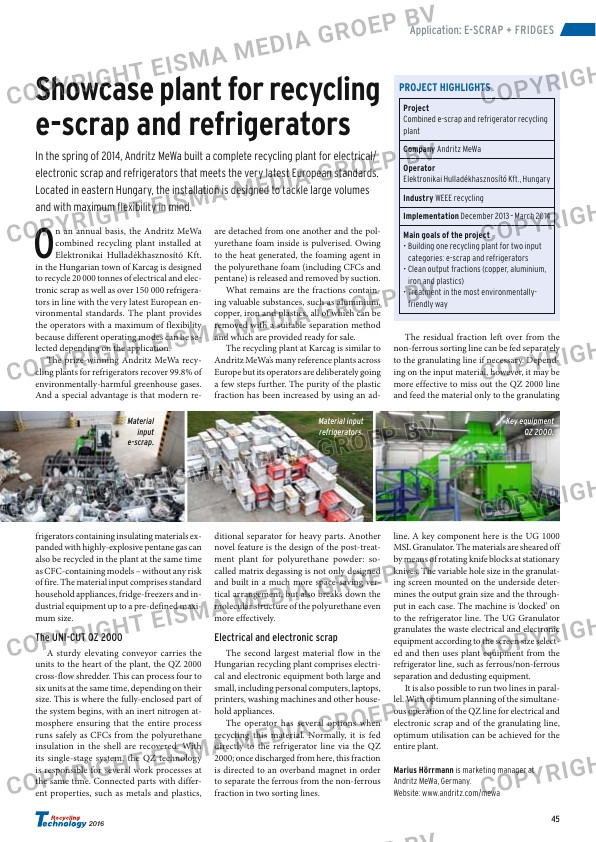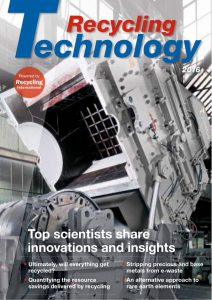Page 45 from: Recycling Technology 2016

45
2016
Application: E-SCRAP + FRIDGES
Showcase plant for recycling
e-scrap and refrigerators
In the spring of 2014, Andritz MeWa built a complete recycling plant for electrical/
electronic scrap and refrigerators that meets the very latest European standards.
Located in eastern Hungary, the installation is designed to tackle large volumes
and with maximum flexibility in mind.
O
n an annual basis, the Andritz MeWa
combined recycling plant installed at
Elektronikai Hulladékhasznosító Kft.
in the Hungarian town of Karcag is designed
to recycle 20 000 tonnes of electrical and elec-
tronic scrap as well as over 150 000 refrigera-
tors in line with the very latest European en-
vironmental standards. The plant provides
the operators with a maximum of flexibility
because different operating modes can be se-
lected depending on the application.
The prize-winning Andritz MeWa recy-
cling plants for refrigerators recover 99.8% of
environmentally-harmful greenhouse gases.
And a special advantage is that modern re-
frigerators containing insulating materials ex-
panded with highly-explosive pentane gas can
also be recycled in the plant at the same time
as CFC-containing models – without any risk
of fire. The material input comprises standard
household appliances, fridge-freezers and in-
dustrial equipment up to a pre-defined maxi-
mum size.
The UNI-CUT QZ 2000
A sturdy elevating conveyor carries the
units to the heart of the plant, the QZ 2000
cross-flow shredder. This can process four to
six units at the same time, depending on their
size. This is where the fully-enclosed part of
the system begins, with an inert nitrogen at-
mosphere ensuring that the entire process
runs safely as CFCs from the polyurethane
insulation in the shell are recovered. With
its single-stage system, the QZ technology
is responsible for several work processes at
the same time. Connected parts with differ-
ent properties, such as metals and plastics,
are detached from one another and the pol-
yurethane foam inside is pulverised. Owing
to the heat generated, the foaming agent in
the polyurethane foam (including CFCs and
pentane) is released and removed by suction.
What remains are the fractions contain-
ing valuable substances, such as aluminium,
copper, iron and plastics, all of which can be
removed with a suitable separation method
and which are provided ready for sale.
The recycling plant at Karcag is similar to
Andritz MeWa’s many reference plants across
Europe but its operators are deliberately going
a few steps further. The purity of the plastic
fraction has been increased by using an ad-
ditional separator for heavy parts. Another
novel feature is the design of the post-treat-
ment plant for polyurethane powder: so-
called matrix degassing is not only designed
and built in a much more space-saving ver-
tical arrangement, but also breaks down the
molecular structure of the polyurethane even
more effectively.
Electrical and electronic scrap
The second largest material flow in the
Hungarian recycling plant comprises electri-
cal and electronic equipment both large and
small, including personal computers, laptops,
printers, washing machines and other house-
hold appliances.
The operator has several options when
recycling this material. Normally, it is fed
directly to the refrigerator line via the QZ
2000; once discharged from here, this fraction
is directed to an overband magnet in order
to separate the ferrous from the non-ferrous
fraction in two sorting lines.
The residual fraction left over from the
non-ferrous sorting line can be fed separately
to the granulating line if necessary. Depend-
ing on the input material, however, it may be
more effective to miss out the QZ 2000 line
and feed the material only to the granulating
line. A key component here is the UG 1000
MSL Granulator. The materials are sheared off
by means of rotating knife blocks at stationary
knives. The variable hole size in the granulat-
ing screen mounted on the underside deter-
mines the output grain size and the through-
put in each case. The machine is ‘docked’ on
to the refrigerator line. The UG Granulator
granulates the waste electrical and electronic
equipment according to the screen size select-
ed and then uses plant equipment from the
refrigerator line, such as ferrous/non-ferrous
separation and dedusting equipment.
It is also possible to run two lines in paral-
lel. With optimum planning of the simultane-
ous operation of the QZ line for electrical and
electronic scrap and of the granulating line,
optimum utilisation can be achieved for the
entire plant.
Marius Hörrmann is marketing manager at
Andritz MeWa, Germany.
Website: www.andritz.com/mewa
PROJECT HIGHLIGHTS
Project
Combined e-scrap and refrigerator recycling
plant
Company Andritz MeWa
Operator
Elektronikai Hulladékhasznosító Kft., Hungary
Industry WEEE recycling
Implementation December 2013 – March 2014
Main goals of the project
categories: e-scrap and refrigerators
iron and plastics)
friendly way
Material
input
e-scrap.
Material input
refrigerators.
Key equipment
QZ 2000.



